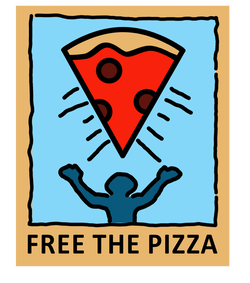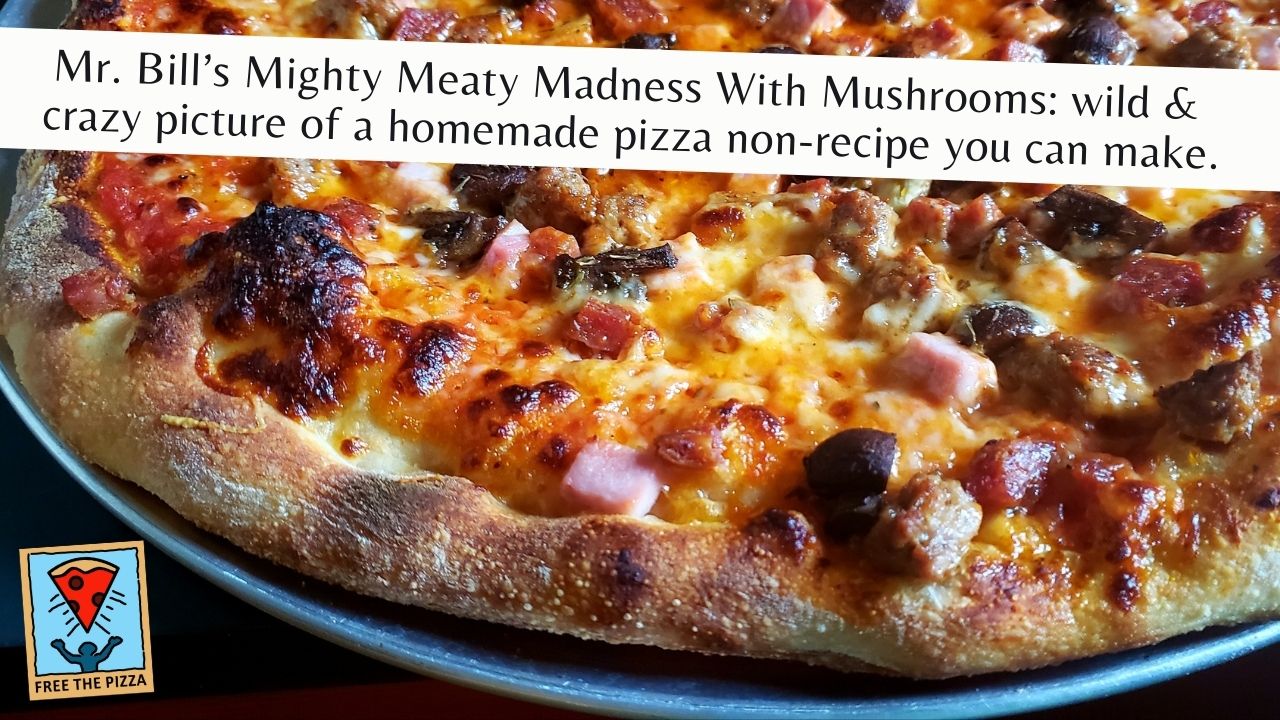|
Last week, I created a pizza called Mr. Bill’s Mighty Meaty Madness With Mushrooms. It’s a tribute to Bill, a friend of ours who likes a meat-forward pizza. Would you like the recipe? I don’t have one. And this makes people crazy. I don’t have codified recipes. I contend that pizza is not recipes. Pizza is practice. Making pizza is not a one-time thing. You have to first learn the process of how to make a basic dough recipe, and then turn it into a pizza. Once you do that, you become a practitioner of pizza. I can give you the closest thing I have to a recipe for Mr. Bill’s Mighty Meaty Madness With Mushrooms. And that is showing you how I developed it. (If you already know how to make pizza, you can jump ahead to the non-recipe at the bottom of this tale.) First, we’re going to talk just a little bit about recipes and why I say you don’t need them. This is not a hard and fast rule. It’s a general philosophy. At some point, recipes must happen. But I digress.
Do you know why you and I are anywhere near smart enough to make pizza? Scientists believe it’s because humans learned how to cook. Learning to cook our food made our brains bigger. Educated guess says that humans have been preparing food with heat for 1 to 2 million years. By contrast, Gutenberg invented the movable-type printing press around 620 years ago. So it stands to reason that human beings have been cooking without cookbooks for almost 2 million years. Cooking food makes it taste better, makes it more digestible, makes nutrients more readily available to our systems, and it makes food safer. That’s unless you’ve ever had my late grandmother’s traditional apple pie gone horribly wrong. But that’s a story for another time. We must have some kind of genetic programming that helps us understand cookability. And even if you look at the tiny sliver of human history where cookbooks intruded into our otherwise blissfully ignorant kitchen practices, the early cookbooks were scant. Take for instance, a bread pudding recipe. I just went to a popular online recipe resource and pulled up a recipe for bread pudding. And it actually says, “Every home cook needs a go-to bread pudding recipe.” (And I bet that you don’t even have one, do you?) The bread pudding recipe that follows is 620 words. If you read that aloud at a comfortable pace, it would take almost 5 minutes. Here’s the bread pudding recipe from what is widely regarded as the first cookbook written by an American, American Cookery by Amelia Simmons: “One pound soft bread or biscuit soaked in one quart milk, run thro' a sieve or cullender, add 7 eggs, three quarters of a pound sugar, one quarter of a pound butter, nutmeg or cinnamon, one gill rose-water, one pound stoned raisins, half pint cream, bake three quarters of an hour, middling oven.” That recipe is 53 words long. You can read it aloud in 20 seconds. Someone listening to you might even remember it. (Unless they got thrown of track by thaty demand for a gill of rosewater.) And here’s a bonus recipe. Eliminate the sugar, butter, spices, rosewater, and raisins. Add tomatoes, cheese, oregano, basil, sausage and mushroom, and you have a pizza bread pudding. Yay, pizza bread pudding! Can you ever have enough good, solid recipes for pizza-like objects? Even if I’m not the first, I just invented pizza bread pudding. Invention in the kitchen is just not that hard when you haven’t been brainwashed into the illusion of recipe necessity. So let’s assume you know how to make a cheese pizza. You’ve got your dough, sauce and cheese program down. You’ve also made some basic pizzas--like pepperoni, sausage and mushroom, anchovy, or some ghastly rendition of un-Hawaiian pineapple mistake pizza. (For the record, I’m not anti-pineapple on pizza. I’m anti-look-at-me-being-an-outlier pizza.) You have the basic skills. Here’s how I approached the puzzle of Mr. Bill’s Mighty Meaty Pizza With Mushrooms. Lots of meat usually means lots of fat. And lots of fat means a greasy pizza. So I knew I’d need to par-cook at least some of the meats. But the other challenge with meats is the old Blazing-Hot Meat-Flap Effect. Take pepperoni, for example. We’ve all had that moment where you take a bite, and the entire slice of greasy pepperoni slides, whole, off the cheese, it flaps down onto your chin, you scream and do a little dance and a handsome second-degree burn blisters up on your chin and makes it hard to shave the next day. (Unless you’re of a gender that doesn’t require a shave. Hello, colorful cartoon Band-Aid of your choice.) With all this meat to come, I want to ensure no blazing-hot greasy meat flaps. We’re going to use small chunks. And thinking about these small chunks, it seems we have two additional benefits. Chunks of meat have less surface area. That means they will render less fat during the bake. It also means that we can develop a more composed pizza. Small chunks of meat closer together mean greater likelihood of every component in each bite. As for the mushrooms (the meatiest of vegetables!), we’re going to chunk them as well. We’re also going to roast them. Mushrooms are largely water. By cooking off some of that moisture for baking them onto the pizza means less likelihood of a soggy, floppy crust. Plus, roasting the mushrooms with salt, herbs and garlic turns them into tiny flavor bombs. Yay, tiny flavor bombs! (I’m roasting mushrooms for pizza with ever greater frequency.) We’re going to use Cremini mushrooms for this. They’re nice and symmetrical. It’s easy to quarter them for good little chunks, then season and roast. Ten minutes in a 350-degree oven worked well—but your mileage may vary. You have to check them during the roast. (Recipes don’t know how well your oven works and how good your pans are.) What meats are we going to use? Italian sausage is a favorite, so we’re going there. The sausage must also be par-cooked so we can render off some of that fat. Smoked Virginia ham? Why not. Spanish chorizo for a little spicy contrast. The sausage and the ham were cut into chunks of about 3/8 of an inch. The chorizo is a cured meat and it’s bold and sassy, so those chunks were cut a little smaller. And no, I did not weigh my toppings. I went with the idea that for a 16-inch pizza, a handful of each meat would provide sufficient coverage. For the mushrooms, they shrink during roasting. I figured two handfuls would work. So, if I were going to give you a recipe? Following is what that recipe would look like: Recipe for Mr. Bill’s Mighty Meaty Pizza With Mushrooms INGREDIENTS - One doughball for a 16-inch pizza - Tomato-based pizza sauce - Mozzarella, shredded - Romano, grated - Mushrooms quartered, two handfuls - Garlic cloves, salt, herbs and olive oil for roasting the mushrooms - Italian sausage, one handful of 3/8-inch chunks (about one link) par-cooked - Smoked Virgina ham, one handful of 3/8-inch chunks - Spanish chorizo, one handful of 1/4-inch chunks INSTRUCTIONS: Assemble a cheese pizza. Then, evenly distribute all meats and mushrooms around the pie. Bake on a 550-degree steel while using the broiler, turning the pizza once, until the crust is nicely browned. See that recipe? It doesn’t make much sense to anyone who hasn’t already learned how to make a pizza. This is why pizza recipes aren’t very useful. Making a pizza requires practice. Instructions for how to play Claude Debussy’s “Clair de lune” on a clarinet aren’t much use if you haven’t already learned how to play the clarinet. Pizza recipes are unfair. Generally speaking, recipes lull the user into a sense of complacency that a degree of success will ensue at the end of the process. A recipe for a pizza is never going to come with a guarantee of success because pizza is a practice. Additionally, learning to make it requires practice. And the more you practice, the better your pizza gets. This is why I wrote Free The Pizza: A Simple System For Making Great Pizza Whenever You Want With The Oven You Already Have. It’s a clear and simple path to pizza. It provides context for why you’re doing what you’re doing. It shows you technique. And most important, it works from a place of assumed success. If illiterate peasants in the 16th century could make pizza in primitive ovens without recipe books, why can’t you make pizza in your modern home oven with the right tools and simple knowledge? If you’re making pizza, enjoy Mr. Bill’s pizza. If you want to learn to make pizza with a simple fun book that’s a quick read, you can learn more about Free The Pizza by clicking here.
0 Comments
Leave a Reply. |
AuthorBlaine Parker is the award-winning author of the bestselling, unusual and amusing how-to pizza book, Free The Pizza. Also known as The Pizza Geek and "Hey, Pizza Man!", Blaine is fanatical about the idea that true, pro-quality pizza can be made at home. His home. Your home. Anyone's home. After 20 years of honing his craft and making pizza in standard consumer ovens across the nation, he's sharing what he's learned with home cooks like you. Are you ready to pizza? Archives
July 2024
Categories
All
|
© Copyright 2021, 2022, 2023, 2024. All rights reserved.
As a ShareASale Affiliate and an Amazon Associate, we earn a small percentage from qualifying Amazon purchases at no additional cost to you.
When you click those links to Amazon (and a few other sites we work with), and you buy something, you are helping this website stay afloat, and you're helping us have many more glorious photographs of impressive pizza.
When you click those links to Amazon (and a few other sites we work with), and you buy something, you are helping this website stay afloat, and you're helping us have many more glorious photographs of impressive pizza.


 RSS Feed
RSS Feed